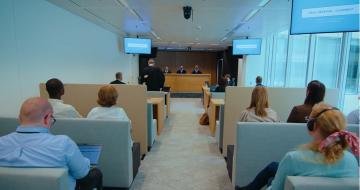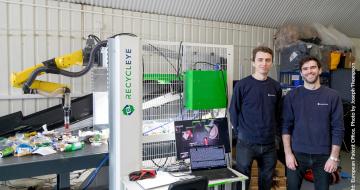Table of Contents
In order to be protected by copyright, the work must:
- result from a creative activity;
- have a concrete shape;
- be original.
In order to be protected by copyright, it is not necessary:
- for the work to be a certain size, duration, length, etc.;
- for the work to be intended for a certain type of use or function;
- for the work to have a particular aesthetic value;
- for the work to be broadcast via a particular medium;
- for the author of the work to create it as part of his professional activities;
- for the work to be in accordance with good moral standards;
- for the author to carry out certain formalities.
The work must be the result of a creative activity
Copyright protects "literary or artistic" works.
This concept must be understood in a much broader sense than merely ‘Fine Arts’. Any creation of the human mind which is carried out in a literary or artistic language and which includes graphic, pictorial, cinematographic, photographic, musical, sculptural or other forms of expression, may be protected by copyright.
The following examples can be protected by copyright:
- in the literary field: novels, poems, plays, scientific or utilitarian texts (e.g. instructions for use), lectures or any other written material;
- in the graphic, pictorial or visual field: paintings, drawings, lithographs, engravings, photographs, comic strips, logos, geographical maps or any other creation in visual form;
- in the musical or sound field: musical compositions of any kind, songs, operas, jingles, mobile phone ringtones, etc.;
- in the audiovisual field: fiction films, documentaries or other films, cartoons, flash animations, video games, PowerPoint presentations, etc.;
- in other creative fields: sculptures, architectural works, works of applied art (such as design), choreography, software, etc.
However, the following examples cannot be protected by copyright:
- anything which already exists in nature (e.g. a colour, a shell that is found on a beach);
- anything that is exclusively performed by a machine (e.g. satellite images);
- anything that is not created by a human (e.g. a drawing made by an animal);
- technical inventions (these can be protected by a patent);
- exclusively sports-related performances;
- official deed of a public authority (laws, decrees, ordinances, regulations, debates in parliamentary assemblies, court decisions, advice of the public prosecutor, etc.).
The work must have a concrete shape
Creation must have a concrete form which can be perceived by the senses.
As such, the protection does not cover the idea or the concept which the work is based on, but the expression or formal execution of this idea.
Copyright does not protect ideas. The work is “an idea that was shaped”. Only this result is protected by copyright, not the idea itself. It is, therefore, always permitted to use the idea underlying a work, and to re-exploit it differently, by making it concrete in another way.
The fact that the work must have a concrete shape in order to qualify for copyright protection does not mean that the work must be on a material support.
The formal expression is sufficient when, for example, a speaker gives a lecture in public, or when an improvised song is performed or played in public. Similarly, a choreography’s form is sufficient even if it was merely prepared in the choreographer's mind before being performed.
In the latter cases, the creation is audible or visible to third parties and the work is, therefore, given a "concrete form of expression".
Neither methods nor ideas can be protected by copyright. Examples of methods are cooking recipes, working methods, teaching methods, mathematical methods and scientific themes or theorems.
The style of an author or a work is not protected either. For example, cubism is a painting genre and rap is a music genre. These are methods for painting or making music. They are, therefore, not in themselves eligible for protection by copyright and they cannot be appropriated by somebody.
The creation must be original
In order to be protected by copyright, a work must be original. Please note that the originality requirement of a work does not have the same meaning as what is generally understood by "originality".
In order to benefit from copyright protection, it is not necessary that the work be of a new kind or the result of a particular effort of imagination, or even that it be new.
Within the context of copyright, a work is original if it "reflects the personality of its creator".
The work will reflect the personality of its author if it is defined by the artistic choices that he or she was able to make when faced with various possibilities, it transcends the mere technical interpretation.
For example, although porcelain dental crowns or gold teeth may be unique and expertly crafted by the dentist, the shape of the artificial tooth is defined by its functional requirements (size, shape, colour, strength, etc.). The dentist is not given sufficient artistic freedom to shape the tooth in his own personal way. Therefore, the shape of the tooth is an element that was not chosen by its author because it was impossible for him to "do otherwise", due to the functionality of the work.
The same applies, for example, to the design of a mobile phone, which may be protected by copyright. However, not all elements of the phone will be protected. For example, the fact that the receiver is located in the upper part of the model and the microphone in the bottom part is essential due to the characteristics of the human face. Someone who designs a telephone model has no other choice. Consequently, another model of mobile phone that has the same layout for the receiver and microphone would not be counterfeit.
On the other hand, a photograph of a person, even if the subject imposes certain requirements, will be taken differently by various photographers who can make different choices in terms of framing and light. A painter who decides to paint sunflowers, even if they have already been painted by Van Gogh, could create an original work within the meaning of copyright.
This originality requirement is fairly easily met because the courts and tribunals give a lot of leeway in this respect. As such, a utilitarian work (the instructions for use of a device, for example) may be considered original if its form would have been different if it had been made by another person than its author.
It does not depend on the completion of formalities
Once the requirements of concrete shape and originality are met, the creation is protected by copyright. There is no need to complete any formalities. Copyright protection automatically exists by the mere creation of an original work.
This means there are no administrative formalities to deal with in order to obtain copyright, as opposed to industrial property rights (for example a patent or trademark right).
However, it may be useful to complete certain formalities that will provide the author with proof of the date when the work was created and of the fact that he or she is the author of the workl. These formalities can include the registration or filing of the work.


